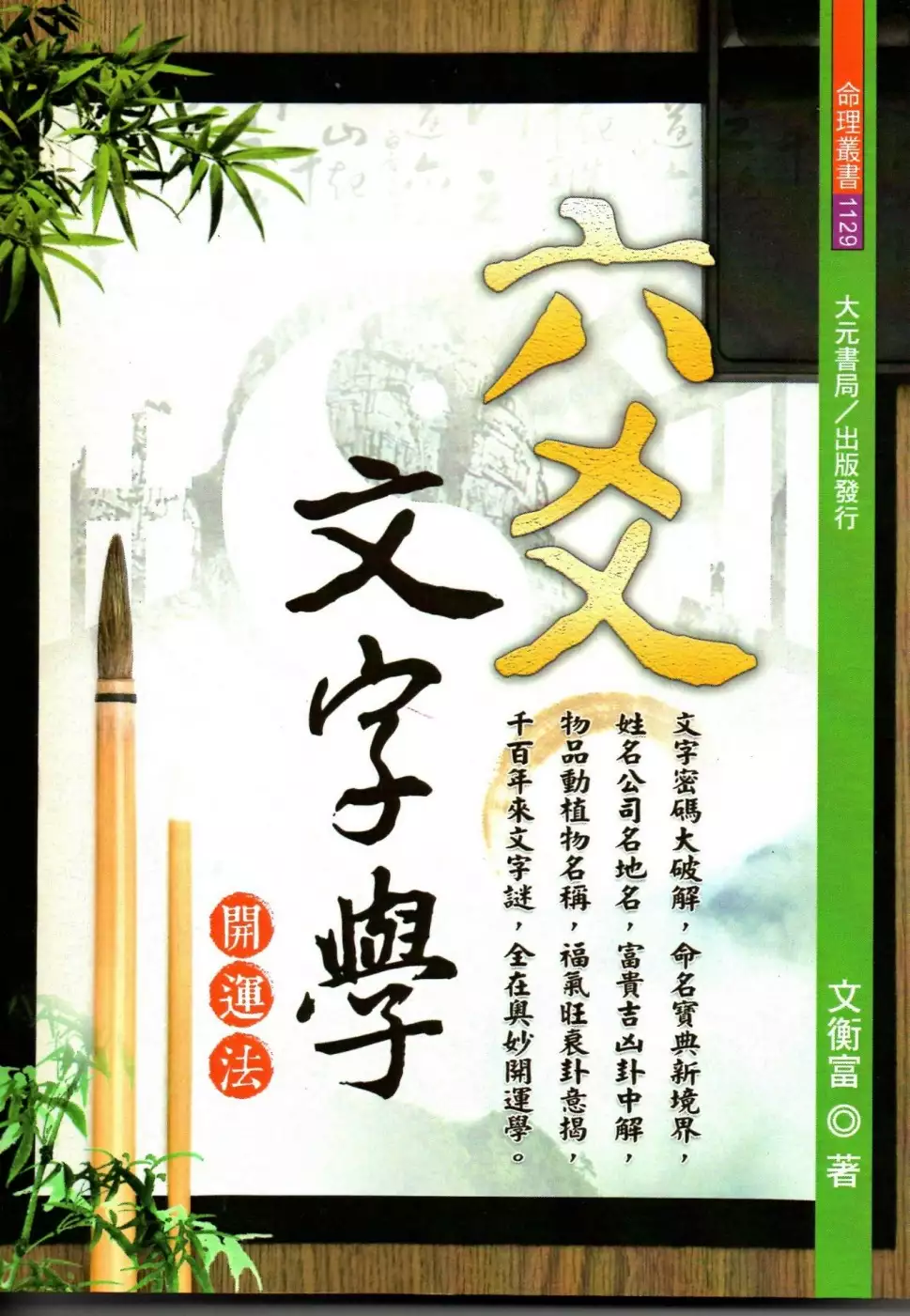迪 麗 熱巴 公司的問題,我們搜遍了碩博士論文和台灣出版的書籍,推薦文衡富寫的 六爻文字學開運法 和ElizabethGouslan的 時尚頑童高堤耶都 可以從中找到所需的評價。
另外網站張彬彬與楊冪合作10年不續約旗下迪麗熱巴 ... - Yahoo奇摩新聞也說明:2022年7月13日 — 大陸演藝圈競爭激烈,娛樂公司「嘉行傳媒」旗下擁有不少高人氣明星,當紅一線女王楊冪不僅是嘉行最大招牌,也持有公司股份。日前,男星張彬彬宣布不再 ...
這兩本書分別來自大元書局 和馬可孛羅所出版 。
國立臺北藝術大學 音樂學系博士班 吳榮順所指導 魏心怡的 從離散到“雙邊音聲”:藏戲「阿吉拉姆」前演「頓」之音樂研究 (2011),提出迪 麗 熱巴 公司關鍵因素是什麼,來自於西藏、西藏自治區、印度流亡藏區、離散、雙邊音聲、藏戲「阿吉拉姆」、前演「頓」、雪頓、覺木隆派、藍面具派、文化適應、溫巴、甲魯、拉莫。
最後網站張彬彬與楊冪合作10年不續約旗下迪麗熱巴粉絲求1事 - MSN則補充:大陸演藝圈競爭激烈,娛樂公司「嘉行傳媒」旗下擁有不少高人氣明星,當紅一線女王楊冪不僅是嘉行最大招牌,也持有公司股份。日前,男星張彬彬宣布不再 ...
六爻文字學開運法

為了解決迪 麗 熱巴 公司 的問題,作者文衡富 這樣論述:
姓名對人生的作用,到底有多大的影響?筆者有興趣探究,也學過多派姓名學,但始終認為八字的準確率較高,名字雖有學問,但在年月應期方面,較難驗證。 2017年出版「六爻神卦推運法」一書後,卦象理解更熟練,將名字成卦解析時,開始只覺得好玩有趣,但後來愈見精彩,結婚、離婚、事業、財運、健康、安全等,興衰時間居然能與卦象相呼應,想像力愈豐富,就能解析愈多的人生密碼。 本書以六爻卦引領讀者入門,因應卦象故事解密,可真正領悟到文字的奧妙,解卦的技巧神奇,不同於一般,讀後能應用開運,即是福氣!
迪 麗 熱巴 公司進入發燒排行的影片
《你是我的榮耀》You Are My Glory,2021年的中國大陸都市愛情電視劇,根據顧漫同名小說改編,由上海騰訊企鵝影視文化傳播有限公司出品,王之執導,原著作者顧漫擔任編劇,並由潘粵明、胡可、王彥霖、楊洋、迪麗熱巴、鄭合惠子聯合主演,該劇在2021年7月26日起於騰訊視頻、台灣WeTV播出。劇情描述人氣女星喬晶晶(迪麗熱巴飾)與高中時單戀的學神于途(楊洋飾),在闊別十年後,於線上再度重逢,開啟了一段浪漫治癒的暖愛之旅。時光匆匆,此時于途已成為心懷夢想的航天設計師,喬晶晶也成為星光閃耀的當紅女明星,時光匆匆,你依舊在我心中閃耀,我是否也能成爲你的榮耀?二人在追夢路上努力堅守,在浪漫奇遇中相互鼓勵,終成彼此榮耀。
#楊洋 #你是我的榮耀 #迪麗熱巴
🎇【官品心劇情聊天室 Podcast 收聽資訊】
Apple:https://apple.co/3aamd8T
Mixer Box:https://www.mixerbox.com/podcast/1255979
SoundOn:https://player.soundon.fm/p/0d55bf39-09f6-4776-8e6d-133e7a595551
Spotify:https://pse.is/3lwj7u
MyMusic:https://www.mymusic.net.tw/podcast/channel/4599
Google:https://pse.is/3lal7c
KKBOX:https://pse.is/3mfpmu
🎇了解更多品心私下的生活
官品心IG https://www.instagram.com/pinhsinkuan
官品心 Facebook https://www.facebook.com/pinhsinkuan
合作邀約:[email protected]
從離散到“雙邊音聲”:藏戲「阿吉拉姆」前演「頓」之音樂研究
為了解決迪 麗 熱巴 公司 的問題,作者魏心怡 這樣論述:
The 1959 political breakup caused a “One Tibet, two regions”. One mainly part of Tibetans settled in indigenous Tibet where belongs to the Tibetan Autonomous Region, another part of them located in Qinghai, Gansu, Sichuan and Yunnan province in China. The other Tibetans followed their theocratic le
ader, H.H. 14th Dalai Lama, crossed the Himalayas to build up the Tibetan exile government and settlements in India. To the Tibetan people, the exile was a painful experience. Besides, the 1959 political event was an important watershed for Tibetan history. From then on, the Tibetan opera “a-lce-lha
-mo” has distinct developments in the Tibetan Autonomous Region and in India’s Tibetan Refuge for 50 years. Although in the 50 some years, there have been fragmentary performances, some vocal data products, or interaction through commerce and travel between two regions, basically, the political stan
ce of the Tibetan Autonomous Region and the India Tibetan Refugee Area are different and cultural exchanges have also been broken. This is the reason why they each maintain their own traditional systems, expressions of performance and musical esthetics. The author believed that such parallel develop
ment can be described by using the music terminology “paraphony”, originally used to describe the coexistence of 4th degree and 5th degree interval in music. Later it was used by modern Netherland scholar Mark C. van Tongeren to describe the coexistence of the fundamental and overtone music phenomen
on. The author now uses this term to describe the dual parallel development of culture and the relation between those residing in Tibet and those exiled from Tibet.The prelude “don” is the first part of Tibetan Opera “a-lce-lha-mo”. Its music has the most fixed form. In this part, there are three ma
in roles-rngon-pa, rgya-lu and lha-mo. Professor Lobsang Dorjee (blo-b.zang-rdo-rje) ever mentioned the functions of their individual performances as “The rngon-pa cleans and exorcises the bad luck of earth”, “The rgya-lu gives blessings to others”, “The primary mission of lha-mo is to dance and sin
g”, therefore the character of the prelude “don” is mainly on ceremonial affection rather than on dramatic entertainment. During Tibetan Opera Festival “zho-ston”, “don” has to be performed in different places, symbolizes the consolidation of religious core and social stratum. Nevertheless, the hier
archy of Tibet gradually has been destroyed in two regions after the diaspora of Tibetan people. The Tibetan Opera becomes an artistic form to bond the ethnic consciousness in exile Tibet and the performance venues have been transferred from temple to school; on the other hand, the “a-lce-lha-mo” in
the Tibet Autonomous Region still celebrated every year in the Monastery and Norbulingka. As the Lhasa residents said, “a-lce-lha-mo” has two drafts scripts, one is to suit the Chinese government’s taste and the other is to service the Tibet People. Within Tibet, there are two kinds of esthetics de
veloped, one caters to the Chinese leadership''s taste as Han style Tibetan Opera, and the other maintains the folk esthetics of Tibetan Opera.When anthropologist Julian H. Steward proposed the ecology adaptation and cultural accommodation, he advocated that human behavior is not a routine one in ac
cordance with the cultural pattern, but is a rational one. In this viewpoint, no matter whether cultural traits are from diffusion or self-invention, they are integrated into a useful organization. Cultural transmission is not unchangeable. According to this theory, the author considers that the Tib
etan people crossed the Himalayas due to the 1959 political external force and came to Dharamsala in the Kangra area of Himachal Pradesh province in northwest India. They set up the Tibetan government in exile and many communities, schools, etc., all over India for the past 50 some years.To sum up,
the dissertation is divided into two parts, the first part emphasizes the prelude “don” and its historical development, the source of its movements, music analysis, etc. Discussing the general character viewpoint at different stages, the development and structure of “a-lce-lha-mo” in different times
, the source of “a-lce-lha-mo” and the elements acquired from other religious dance, music, and traditional performing arts. The second part analyzes the instances of field research and music phenomenon after the 1959 political separation, and the individual developments and changes of the two regio
ns, and explains works lost due to the separation when Tibetans passed down their music. Finally, the author studied the phenomenon of Tibet, from diaspora to the “paraphonic” and expounds the issues such as “From Tibet to India: the music change through political and environmental accommodation”, “
The two types of Tibetan Opera mechanisms in Tibet”, “In Tibetan Opera, the vanishing pieces by diaspora and migration”, “The changing meaning of the cultural pattern”, “The paraphonic: creation and re-presentation of traditional culture in two social facts”, etc.
時尚頑童高堤耶

為了解決迪 麗 熱巴 公司 的問題,作者ElizabethGouslan 這樣論述:
高堤耶顛覆時尚三十年,中文世界第一本傳記問世 感性與龐克的混搭風,重新定義時尚傳奇 顛覆性別的制約,讓內衣外穿、男人著裙裝 不論認同或反對,沒有人能對高堤耶無動於衷! 芭蕾舞裙配短身皮夾克,過膝長靴搭寬大條紋衫,當然,誰忘得了那驚世駭俗的圓錐馬甲!──從未停止反叛腳步的「壞男孩」高堤耶,自七○年代起便持續在全球時尚界製造噪音,注入震撼。他大膽將街頭文化帶進高級時裝,將秀場轉變成劇場,並率先起用不同體態、種族甚至素人模特兒走秀。香奈兒和聖羅蘭將中性風格融入女性服飾,然而,是高堤耶進一步挑戰了男性形象,讓男人穿上裙裝。他顛覆常規的作風重新定義了美的概念,使得時尚更加豐富多元。
高堤耶的品牌風格前衛,但本人總是帶著溫煦的笑容;他的設計一出手無不是大膽的政治宣言,個人卻相當簡約低調,注重隱私。本書是高堤耶在時尚界嬉遊三十年來第一本文字傳記,讓讀者首度有機會在「馬甲」的刻板印象之外,深入認識這位調皮的大男孩、多愁善感的龐克。高堤耶生命中重要的際遇盡錄書中,除了與各界名流合作的祕話、親友的貼身評價,他失去家人及愛侶時的哀痛與強忍,更是高堤耶少見的晦暗一面。辜斯蘭優美的筆觸與記述,完整呈現了這位時尚大師獨特的創作歷程,同時側寫了八○年代後的時裝發展與社會變革,讀來宛如親臨一場令人心醉神迷的時裝秀。 本書特色 1. 中文世界第一本高堤耶傳記 2. 高堤耶獨特的時尚啟蒙、養
成歷程 3. 密友及親人對他的貼身觀察與評價 4. 高堤耶與眾名流交手的合作祕辛 5. 側寫時裝發展史,八○年代後的時代社會變革 作者簡介 伊莉莎白.辜斯蘭(Elizabeth Gouslan) 文化記者。自索邦大學取得文學碩士後,進入資深記者讓-封梭.坎(Jean-Francois Kahn)所創辦的《週四事件》(L’Evenement du Jeudi)週刊直到停刊,其後任職於《法國晚報》(France-Soir)、《費加洛報》(Le Figaro)文學版與《費加洛雜誌》(Madame Figaro)文化版。 譯者簡介 周明佳 巴黎第五大學社會學碩士。熱愛閱讀,譯有:《艾蜜莉
的日本求生記》、《拉美西斯二世》、《血與聖杯之謎:公審達文西密碼》及《非洲慾經》等書。
迪 麗 熱巴 公司的網路口碑排行榜
-
#1.傳迪麗熱巴將與楊冪公司解約自建工作室粉絲一致叫好:脫離苦海
眾所周知,迪麗熱巴是楊冪公司「嘉行傳媒」旗下藝人,還為其成立了「嘉行迪麗熱巴工作室」,可以說熱巴的走紅離不開楊冪的資源和公司的栽培。 於 www.hk01.com -
#2.同处一家经纪公司,资源仅次于迪丽热巴,杨幂也没能把她带红
嘉行传媒算是娱乐圈比较知名的艺人经纪公司,作为股东之一的杨幂也是当下非常火爆的明星,旗下的女艺人迪丽热巴也是顶流女演员,目前由迪丽热巴与 ... 於 www.sohu.com -
#3.張彬彬與楊冪合作10年不續約旗下迪麗熱巴 ... - Yahoo奇摩新聞
2022年7月13日 — 大陸演藝圈競爭激烈,娛樂公司「嘉行傳媒」旗下擁有不少高人氣明星,當紅一線女王楊冪不僅是嘉行最大招牌,也持有公司股份。日前,男星張彬彬宣布不再 ... 於 tw.tech.yahoo.com -
#4.張彬彬與楊冪合作10年不續約旗下迪麗熱巴粉絲求1事 - MSN
大陸演藝圈競爭激烈,娛樂公司「嘉行傳媒」旗下擁有不少高人氣明星,當紅一線女王楊冪不僅是嘉行最大招牌,也持有公司股份。日前,男星張彬彬宣布不再 ... 於 www.msn.com -
#5.張彬彬與楊冪合作10年不續約旗下迪麗熱巴粉絲求1事
大陸演藝圈競爭激烈,娛樂公司「嘉行傳媒」旗下擁有不少高人氣明星,當紅一線女王楊冪不僅是嘉行最大招牌,也持有公司股份。日前,男星張彬彬宣布不再 ... 於 www.chinatimes.com -
#6.真不合?迪麗熱巴生日楊冪1舉動秒曝兩人關係
娛樂中心/翁語岑報導. 迪麗熱巴擁有新疆維吾爾血統,五官深邃,身材火辣,是楊冪創立「嘉行傳媒」公司旗下的高人氣演員,演出過多部熱門電視劇,在微 ... 於 today.line.me -
#7.傳迪麗熱巴約滿離巢楊冪公司澄清雙方合作愉快 - 澳門力報
內地人氣女星迪麗熱巴,最近憑熱播電視劇《三生三世枕上書》再度爆紅,近日內地網傳她與楊冪的嘉行娛樂經理人合約即將屆滿,並將另投華策懷抱,而下一 ... 於 www.exmoo.com -
#8.終於跳槽了?迪麗熱巴被曝與嘉行解除合約,或空降新公司成一姐
當然啦,經紀公司也並非無辜,也有很多藝人跳槽是為了自己能夠更好的發展,而不是被經紀公司所局限,其中迪麗熱巴就是最後這種情況的代表。 於 twgreatdaily.com -
#9.迪麗熱巴如今資源拉跨,卻為何不離開嘉行傳媒? - 頭條匯
迪麗熱巴 這個出生於1992年的新疆女孩,似乎一出生老天爺就格外偏袒她,給了熱巴漂亮的容顏和完美的身材,在娛樂圈混的風聲水起,雖然近年來熱巴的電視劇沒能達到爆火. 於 min.news -
#10.迪丽热巴一年赚多少钱她在嘉行传媒能分多少呢 - 尚之潮
2014年,有一份经纪公司员工年均排行榜在网络上曝光,嘉行人均34万,具体代表人物是杨幂迪丽热巴,迪丽热巴是公司现在赚钱主力,年收入有5500万人民币, ... 於 m.shangc.net -
#11.迪麗熱巴VR虛擬實境廣告錄影側拍 - YouTube
【荣耀夫妇CUT】杨洋 迪丽热巴 偶像剧式作弊!荣耀夫妇撒糖主持元老看不下去了? 《快乐大本营》Happy Camp丨MangoTV. 芒果TV爱豆MangoTV Idol. 於 www.youtube.com -
#12.迪丽热巴·迪力木拉提 - 维基百科
迪麗热巴 ·迪力木拉提(維吾爾文:دىلرەبا دىلمۇرات;拉丁维文:Dilreba Dilmurat;慣用拉丁轉寫:Dilraba Dilmurat,1992年6月3日-),簡称迪麗熱巴,出生于新疆 ... 於 zh.m.wikipedia.org -
#13.APP疑捲1750億胡軍代言慘被罵爆
沒想到,近日傳出胡軍代言過的理財APP涉嫌詐欺,吸金上千億台幣,公司還疑似捲 ... 草莓園纖細妹包緊緊竟是頂流女星 · 迪麗熱巴零修圖網暈:女神降臨 ... 於 times.hinet.net -
#14.迪丽热巴湿发造型挨批| 中國報China Press
(北京讯)中国女星迪丽热巴早前为其代言的香水品牌进行直播宣传,以黄色晚装露肩晒腿上阵,但其又湿又曲的发型却惹来大批网友劣评。网友先指迪丽热巴 ... 於 www.chinapress.com.my -
#15.人類事評論:漫談這顆以人類為主的星球(《生命中的美好缺憾》作者最具影響力五星Podcast選集)
泰迪熊 0 英文的「熊」( bear )這個字,是來自德文「 bero 」,意思是「那個棕色之 ... 轟動意思的是一家德國公司也在同一時期做出類似的泰迪熊,兩家公司都大獲成功。 於 books.google.com.tw -
#16.周震宇的聲音魅力學: 聽懂弦外之音、用對聲音裡的9種力量
就以1980後的怪力美少女──迪麗熱巴來當代表吧!她聲音裡的甜,一部分來自天生的音質,一部分來自說話態度。熱巴說話時習慣嘴角上揚、帶著笑意,用一點點鼻腔共鳴, ... 於 books.google.com.tw -
#17.迪丽热巴_百度百科
迪丽热巴 (Dilraba),1992年6月3日出生于新疆乌鲁木齐市,中国内地影视女演员。2013年,迪丽热巴因主演个人首部电视剧《阿娜尔罕》而出道。2014年,主演奇幻剧《逆光 ... 於 baike.baidu.com -
#18.迪麗熱巴粉絲爆氣「簽15年賣身契」卻總跟同個男人搞在一起!
迪麗熱巴 的粉絲提到,經紀公司因為《三生三世十里桃花》及《三生三世枕上書》等小說原著捲入抄襲風波,連帶戲劇也受到影響,根本就是連累藝人的名譽受損, ... 於 www.teepr.com -
#19.狗仔爆料「差點拍到鹿晗和迪麗熱巴」 女方公司回應了!葛斯齊 ...
狗仔爆料「差點拍到鹿晗和迪麗熱巴」 女方公司回應了!葛斯齊急發文撇清》正版高畫質娛樂線上看。狗仔爆料「差點拍到鹿晗和迪麗熱巴」 女方公司回應了! 於 m.litv.tv -
#20.迪麗熱巴身高?三圍多少?[30P]素顏無極限,日本喻為中國最美
迪麗熱巴 日本暴動喻為"中國第一美" 從《三生三世十里桃花》認識了迪麗熱巴, ... 活躍年代:2013年至今經紀公司:嘉行傳媒(2014年-2018年) 嘉行迪 ... 於 beautyhair67.pixnet.net -
#21.李奧納多親給建議奧斯汀巴特勒把貓王魂刻進骨子裡 - 鏡週刊
由《大亨小傳》導演巴茲魯曼執導、奧斯汀巴特勒(Austin Butler)主演的傳奇搖滾天王傳記電影《貓 ... 迪麗熱巴跨越禁忌愛情任嘉倫從體內傳遞「信物」. 於 www.mirrormedia.mg -
#22.迪麗熱巴經紀人叫什麼? - 雅瑪知識
迪麗熱巴 的公司叫什麼名字?. 嘉行天下的簽約藝人,就是楊冪的工作室,和高偉光,張雲龍等在同一個公司. 高雯的經紀人是否是迪麗熱巴現實中的經紀人 ... 於 www.yamab2b.com -
#23.男星離開楊冪工作室!迪麗熱巴合約糾紛曝光
中國男星張彬彬簽入楊冪的嘉行工作室10年,直到去年和景甜演出《司藤》才真正爆紅,日前他宣布不再和楊冪續約,讓同公司的當紅炸子雞迪麗熱巴再受到 ... 於 www.ttshow.tw -
#24.祝緒丹成《狐妖小紅娘》女二號,嘉行大禮包總能出爆劇 - ttfnews
狐妖小紅娘#袁冰妍公司偷漏稅被罰97.8萬元,數字不驚人, ... 雖然這部劇的主角應該是圍繞著白淺和夜華,但是迪麗熱巴和高偉光的戲份撐起了這部劇的 ... 於 ttfnews.org -
#25.要离开杨幂旗下? 网传迪丽热巴有意出走...转当陈赫师妹 - Xuan
杨幂有份投资的“嘉行传媒”签约不少艺人,其中最为成功的莫属迪丽热巴,但近日有传双方 ... 亲密的称呼让不少网友都猜测,迪丽热巴是否要离开杨幂旗下,转投其他公司。 於 xuan.com.my -
#26.嘉行為什麼讓迪麗熱巴簽約15年? - 劇多
現在捧新人就是給別人做嫁衣。遠的不說就說南韓SM公司捧出的EXO吧!鹿晗、吳亦凡、黃子韜都是這個組合出來的。公司花了財力、物力捧出來一個個能賺錢的新 ... 於 www.juduo.cc -
#27.迪麗熱巴單飛老闆楊冪的反應證明演藝圈有「真友情」!回顧 ...
迪麗熱巴 是「嘉行天下楊冪工作室」旗下藝人,可以說是被楊冪一手捧紅的,她在4月2日成功開設個人工作室,最特別的是迪麗熱巴選擇了保留公司名稱, ... 於 www.cosmopolitan.com -
#28.新疆四美”洗牌迪麗熱巴遭嫌老| 娛樂 - 光明日报
入行9年的中国女神迪丽热巴,人气依旧旺盛,除了不停拍剧,还红到外国,前阵子还获得印度影视大奖提名,入围“全球最佳女演员”奖,是中国唯一入选的女 ... 於 guangming.com.my -
#29.頂流女神迪麗熱巴必追陸劇推薦!楊洋《你是我的榮耀》
迪麗熱巴 擁有高人氣以及眾多粉絲,身為頂端流量保證的她出演影集或電影的收視率都 ... 《克拉戀人》劇情講述米美麗(唐嫣飾)愛上了克拉鑽石公司裁蕭 ... 於 www.harpersbazaar.com -
#30.娛樂圈6位「錦鯉」明星:肖戰迪麗熱巴不壓戲 - 資訊咖
美麗的迪麗熱巴最大的優勢和劣勢都是外形,由於外形過於明艷,很多角色不太會考慮她,可以說這也是一種限制,而迪麗熱巴在古偶圈算是一線了,她與楊紫是繼 ... 於 inf.news -
#31.迪麗熱巴楊冪
综合讯中国女星迪丽热巴是杨幂公司嘉行传媒旗下艺人公司还为其成立了嘉行迪丽热巴工作室可以说热巴的走红离不开杨幂的资源和公司的栽培. 迪丽热巴. 於 seelma.com -
#32.孕婦絲絨高腰敬酒服新款新娘大尺碼胖mm遮肚子訂婚結婚紅色 ...
下單時請確認收貨人姓名、電話和地址是否無誤❤本公司工廠直接銷售, ... 迪麗熱巴同款洋裝2021外貿日系韩版休闲秋復古酒紅色吊帶性感絲絨訂婚回門小禮服2022裙子收腰 ... 於 shopee.tw -
#33.迪丽热巴10年合约到期,新公司露出水面,迫不及待离开杨幂?
此前一直就有流言说,迪丽热巴和自己的公司嘉行娱乐已经解约了;. 但是对于这些谣传,许多网友都没有在意;. 毕竟人红是非多,像迪丽热巴这样火的艺人这些 ... 於 new.qq.com -
#34.迪麗熱巴 - 觸mii
觸娛樂. 2022/07/14. 大陸演藝圈競爭激烈,娛樂公司「嘉行傳媒」旗下擁有不少高人氣明星 ... 於 www.truemii.com.tw -
#35.楊冪和迪麗熱巴的故事,沒有那麼簡單 - 日日新聞
先去浙江衛視《演員的誕生》、再去《喜劇總動員》,又和佟大為搭檔諜戰劇《絕密者》,還有趙寶剛《青春鬥》是女主角,北京文化子公司的《倩女幽魂》女 ... 於 inewsdb.com -
#36.嘉行迪丽热巴工作室的微博
嘉行迪丽热巴工作室,嘉行迪丽热巴工作室官方微博。嘉行迪丽热巴工作室的微博主页、个人资料、相册。新浪微博,随时随地分享身边的新鲜事儿。 於 weibo.com -
#37.迪麗熱巴被嘉行冷凍?已經8個月沒戲拍,粉絲怒提四大訴求
楊冪為了提攜公司新人接拍的《三生三世十里桃花》,迪麗熱巴憑借在片中飾演的鳳九一角更是圈粉無數。可是現在她的發展路線越來越莫名其妙,一個演員沒有影視作品傍身 ... 於 ek21.com -
#38.狗仔突爆「迪麗熱巴、鹿晗曾同遊日本」 - 民視新聞
娛樂中心/周希雯報導資深狗仔葛斯齊昨(31日)晚開直播,不僅連環爆汪小菲疑似婚內出軌的猛料,還牽扯到多名藝人,其中包括新疆女神迪麗熱巴。 於 www.ftvnews.com.tw -
#39.嘉行老闆「遍地」,花旦迪麗熱巴,為何只是「打工人」? - 壹讀
但是必須承認,坐擁1400多萬粉絲的袁冰妍,雖然古偶劇一部接一部,但只能算是「中小型古偶劇」女主。相對而言,坐擁7000多萬粉絲的迪麗熱巴才算是拿了 ... 於 read01.com -
#40.【曾遭痛罵是花瓶】迪麗熱巴因「長的好看」被楊冪簽下15年擁 ...
中國女星迪麗熱巴出道8年,從默默無聞拼到擠身頂流花旦之列,除靠顏值及演技外,背後老闆也頗有勢力,是早... 於 www.upmedia.mg -
#41.粉丝为何希望迪丽热巴与公司解约?看演员表就明白了 - 今日头条
其实也不难明白,一来,迪丽热巴红了之后嘉行团队给她的过度营销败坏了很多的好感,金鹰节的例子就太明显了。 於 m.toutiao.com -
#42.迪丽热巴、杨幂惊爆不合! - XTRA - TV3
有八卦微博爆料,迪丽热巴6月以个人名艺分别注册上海问羽文化传媒中心、上海镜砚影视文化工作室等两间工作室,原因被指和杨幂不合,决定离开公司。对此经纪公司「嘉 ... 於 www.xtra.com.my -
#43.9位陸劇明星當老闆!趙麗穎是周也的老闆,楊冪是迪麗熱巴的 ...
如今陳鈺琪是唐嫣公司旗下的一姐,她和迪麗熱巴算是同期發展的女演員,迪麗熱巴是楊冪旗下代表,陳鈺琪是唐嫣旗下代表,雖然陳鈺琪的發展不如迪麗熱 ... 於 www.beauty321.com -
#44.為什麼粉絲要求公司,合理規劃迪麗熱巴的資源呢
但是粉絲們的這種要求,迪麗熱巴本人和公司都沒有出來說一句話。雖然迪麗熱巴參演了很多影視作品,但是給觀眾留下深刻印象的唯一角色,是三生三世中的鳳九 ... 於 www.plate.wiki -
#45.解约再度来袭,曝迪丽热巴被嘉行要求带王艺瑾拍戏 - iQIYI
Watch the latest 解约再度来袭,曝迪丽热巴被嘉行要求带王艺瑾拍戏,热巴坚持不肯(2020) Full with English subtitle on iQIYI | iQ.com. 於 www.iq.com -
#46.楊冪公司內部照片曝光,迪麗熱巴在公司的地位 - 雪花新闻
提到杨幂想必许多小伙伴都是非常清楚的了,杨幂在娱乐圈中也是有着一席地位的女星,并且杨幂的名气在娱乐圈中也是非常高的, 提到杨幂想必许多小伙伴都 ... 於 www.xuehua.us -
#47.迪丽热巴- 杨幂旗下的艺人- 明星 - 领英
上领英,在全球领先职业社交平台查看迪丽热巴的职业档案。迪丽热巴的职业档案列出了1 个职位。上领英,查看迪丽热巴的完整档案,结识职场人脉和查看相似公司的职位。 於 cn.linkedin.com -
#48.迪丽热巴爆将与杨幂公司解约粉丝:恭喜脱离苦海
(综合讯)中国女星迪丽热巴是杨幂公司“嘉行传媒”旗下艺人。公司还为其成立了“嘉行迪丽热巴工作室”,可以说热巴的走红,离不开杨幂的资源 ... 於 entlife.8world.com -
#49.迪丽热巴解约嘉行,目前正在协调中,背后金主愿承担违约费
迪丽热巴 嘉行传媒公司艺人,前不久因为《漂亮的李慧珍》拿下金鹰女神,虽然金鹰女神让迪丽热巴备受关注,但同时也为迪丽热巴的事业带来了很大的影响, ... 於 3w.huanqiu.com -
#50.出現審美疲勞!迪麗熱巴簽15年賣身契,粉絲千字文喊話工作室
日前,迪麗熱巴粉絲聯合上書千字文致嘉行傳媒,主要問題是聚焦在因為迪麗熱巴接演新劇《三生三世枕上書》而引發的相關爭議,令粉絲一次點出對嘉行的 ... 於 pretty.presslogic.com -
#51.生日時沒有藝人給祝福:冷清的社群網站,讓迪麗熱巴被嘲笑 ...
外界發現娛樂圈中給迪麗熱巴送上生日祝福的明星藝人寥寥無幾, ... 是我的榮耀》搭檔的男主角楊洋,連同是一個經紀公司的張彬彬、高偉光與張雲龍都沉默。 於 www.adaymag.com -
#52.挖咧!這經紀約也簽太久揭密迪麗熱巴為何簽給楊冪15年【巨星 ...
一說是楊冪認為時間夠長了,主動說出是表明挖角的事你們就別想了,迪麗熱巴從2013年納入楊冪的嘉行娛樂旗下,想要簽她你們再等8年吧。 於 tw.nextmgz.com -
#53.迪麗熱巴油頭造型引吐槽 - 星島日報
迪麗熱巴 2 9 日晚現身某品牌直播間,熱度很高,造型也受到了大家的關注。她身穿黃色掛脖連衣裙,狀態不錯,而她的髮型卻遭到了網友們的吐槽。 於 www.singtao.ca -
#54.By 迪丽热巴Dilraba Dilmurat | 杨幂带领嘉行公司旗下艺人走红 ...
杨幂带领嘉行 公司 旗下艺人走红毯很霸气很有范儿# 迪丽热巴 #嘉行传媒. 於 m.facebook.com -
#55.嘉行賀年卡曝光,旗下藝人排位一目了然,迪麗熱巴公司地位遭 ...
而在中間的四位是楊冪、王驍、黃夢瑩、張雲龍,這幾位都在《三生三世,十里桃花》中有過精彩表現,不過除了楊冪外其他三位的名氣都比迪麗熱巴要差得遠 ... 於 looknews.cc -
#56.GQ TAIWAN: 國際中文版 2018年5月 - 第 60 頁 - Google 圖書結果
這位北京姐長得並不是迪麗熱巴那樣的美人胚,但裝扮起來也頗有女人味,特別是口紅一 ... 我的朋友Simon說來也算是條件不錯的男子,在外商公司當個中階小主管,他是在朋友的 ... 於 books.google.com.tw -
#57.迪麗熱巴單飛拋棄楊冪?其實兩人私下感情超好 - ELLE HK
熱巴 於4月2號成功開設個人工作室,但不同大部份藝人,縱使貴為一線紅星,她依然把公司名保留,名為「嘉行迪麗熱巴工作室」。作為老闆,雖然自己一手捧 ... 於 www.elle.com.hk -
#58.眾神之谷: 《華爾街日報》記者對矽谷創業生態圈的深入調查報導
《華爾街日報》記者對矽谷創業生態圈的深入調查報導 雅麗珊卓. ... 對矽谷的創辦人來說,研討會是企業之間或公司打知名度短暫的完美中間人,可以讓他們傳遞自己的新聞, ... 於 books.google.com.tw -
#59.迪麗熱巴新疆女神的10個秘密!出道是意外?睡前癖好居然是......
和任嘉倫搭檔《與君初相識》、《恰是故人歸》虐心回歸的迪麗熱巴,雖然劇中的季云禾身殘志堅、愛的辛苦,但私下的她可是活潑至極,以下10個新疆女神 ... 於 www.marieclaire.com.tw -
#60.迪麗熱巴公司的支援,原來是楊冪的經紀人,簽約越來越多
迪麗熱巴 [娛樂影響力人物榜✨第64名]. 自出道以來,已經有不少代表作及經典角色出現,比如三生三世十里桃花、克拉戀人等等,算是有娛樂圈地位的女星 ... 於 raolve.com -
#61.拍楊冪自家劇冇口碑? 迪麗熱巴傳被挖角 - 東網
內地女星楊冪除咗係爆紅一線女藝人之外,佢仲係娛樂公司「嘉行傳媒」嘅老闆,至今簽咗男女演員超過20位,而當中數到最紅嘅,肯. 於 hk.on.cc -
#62.楊冪與迪麗熱巴地位不同 - 每日頭條
眾所周知,楊冪與迪麗熱巴都是嘉行傳媒公司的藝人,一個是作為旗下藝人而另一個是作為老闆,發展目標前景不一樣,地位也是不一樣!迪麗熱巴, ... 於 kknews.cc -
#63.恢复自由身?迪丽热巴被曝与嘉行解除合约,或加入新公司拼事业
当然啦,经纪公司也并非无辜,也有很多艺人跳槽是为了自己能够更好的发展,而不是被经纪公司所局限,其中迪丽热巴就是最后这种情况的代表。 迪丽热巴走红 ... 於 www.163.com -
#64.恭喜!迪丽热巴10年合约终到期,新东家为其动态评论“话中有话”
实际上这个完全可以放心,从目前的情况来看,热巴去新公司已经是一个公开的秘密了,而且新公司敢于正大光明地与热巴进行互动,证明三方之间已经没有 ... 於 www.sohu.com -
#65.嘉行為什麼讓迪麗熱巴簽約15年? - 小熊問答
嘉行傳媒和迪麗熱巴簽約15年,我覺得這並不過分,因為藝人和經紀公司就是相互利用的關係,藝人會和公司簽約是看重公司強大的資源,在娛樂圈有資源、 ... 於 bearask.com -
#66.迪麗熱巴15年賣身契曝光網列4罪狀噴經紀公司 - 自由娛樂
娛樂頻道/綜合報導〕25歲中國女星迪麗熱巴,去年演出古裝《三生三世十里桃花》爆紅,近日粉絲聯合寫下千字文,列出經紀公司4項罪證,替偶像抱不平。 於 ent.ltn.com.tw -
#67.一代楊冪,二代迪麗熱巴,嘉行傳媒藝人帶藝人的招,還能走多久?
被罵的最大來源自然是目前嘉行兩大頂流,楊冪和迪麗熱巴的粉絲. 可是罵曾嘉,罵嘉行就能讓 ... 之後,曾嘉看中了當時定位是服務國內年輕觀衆的IP增值服務公司—歡瑞世紀. 於 ppfocus.com -
#68.遭譏諷花瓶卻奪下視后!她超越楊冪成新一代「廣告女王」
新疆美女迪麗熱巴,從出道開始就因為有著精緻的外貌而備受關注,從2013年出道至今,也交出許多代表作,打破外界對於美女總是「花瓶」的既定印象, ... 於 www.setn.com -
#69.嘉行為什麼一直留不住人?迪麗熱巴與嘉行合約到期 - 友快網
首先就是嘉恆一貫的作風啦,一般嘉行的藝人,在爆火了之後,一般都會出演自家公司出品的影視劇,而且在這些影視劇雖然是扛劇的存在,但是說白了就是要 ... 於 uakai.com -
#70.曾拒絕「來台灣發展」 迪麗熱巴曝原因 - Tvbs新聞
近年來,新疆美女迪麗熱巴演藝事業如日中天,其實她出道前是新疆歌舞團的舞蹈人員,那年沒去到北京奧運,卻意外考進上海戲劇學院,走上演員這條路, ... 於 news.tvbs.com.tw -
#71.楊冪迪麗熱巴 - Basemini
楊冪,與迪麗熱巴的關系到底有多好?歡迎訂閱【放映室】:https://is.gd/GmLUyi. 迪麗熱巴是「嘉行天下楊冪工作室」旗下藝人,可以說是被楊冪一手捧紅的,她在4月2日 ... 於 www.karahs.co -
#72.石油戰爭: 當代新知文叢 - Google 圖書結果
... 茲比格紐∙布熱津斯基湯姆∙威克爾威廉∙邦迪羅伯特∙謝策爾卡羅爾∙威爾遜米麗 ... 在石油出口國、石油進口國、石油生產國、國際石油公司的所在國以及生產和進口 ... 於 books.google.com.tw -
#73.迪丽热巴为什么不离开嘉行呢? - 知乎
偏个题,嘉行传媒回应李溪芮解约上热搜了,然后在营销号下的评论都是. 我是真觉得这姑娘惨,人还在给公司赚钱,公司就迫不及待给迪丽热巴艹白眼狼人设,团队下场污蔑 ... 於 www.zhihu.com -
#74.嘉行對迪麗熱巴到底怎麼樣? - GetIt01
都說迪麗熱巴是「第二個楊冪」,嘉行捧出了熱巴,也要讓熱巴像楊冪一樣可以帶新人。近期要播的《烈火如歌》,就是和楊冪的《三生三世十里桃花》一個套路。其中,嘉行的代斯 ... 於 www.getit01.com -
#75.迪麗熱巴 - 噓!星聞
「迪麗熱巴」的相關娛樂內容,噓!星聞一次秀給你。 於 stars.udn.com -
#76.傳迪麗熱巴將與楊冪公司解約自建工作室,粉絲一致叫好 - iFuun
眾所周知,迪麗熱巴是楊冪公司「嘉行傳媒」旗下藝人,還為其成立了「嘉行迪麗熱巴工作室」,可以說熱巴的走紅離不開楊冪的資源和公司的栽培。 於 www.ifuun.com -
#77.打造自動賺錢機器 - Google 圖書結果
據移動互聯網大數據公司QuestMobile統計顯示,抖音用戶的日均使用時間逾1小時,也就是說, ... 到了2018春節期間,抖音又請來當紅演員迪麗熱巴、楊穎等明星發紅包, ... 於 books.google.com.tw -
#78.OKR實現淨零排放的行動計畫 - Google 圖書結果
佛里曼在《世界又熱又平又擠》與《謝謝你遲到了》當中,以生花妙筆為我們綜述世界如何受到 ... 企業家套用人類學家瑪格麗特. ... 萊茵哈特、量子願景電池公司的傑迪普. 於 books.google.com.tw -
#79.嘉行传媒成立七周年杨幂迪丽热巴张彬彬等艺人寄语
转载自https://weibo.com/5044684628/KzjAO8Loh?type=comment. 於 www.bilibili.com -
#80.不合謠言頻傳!迪麗熱巴慶29歲生日楊冪隔空喊「大大寶貝貝 ...
大陸女星迪麗熱巴在今(3)日邁入29歲了!擁有外貌與演技優勢的她,是楊冪公司「嘉行傳媒」旗下的藝人,兩人還曾一同出演電視劇《三生三世十里桃花… 於 ipop.sina.com.tw -
#81.迪麗熱巴去意已決,看到她選擇的公司,粉絲感到放心了
早在前幾年的時候,娛樂圈內就有訊息說,作為新疆四大美女的迪麗熱巴有新的動向,也就是離開嘉行傳媒,尋找到更好的發展的平臺,人往高處走, ... 於 www.gushiciku.cn -
#82.迪麗熱巴工作室已成立名字前還加了「嘉行」二字網友:情商高
盤點當今演藝圈的當紅小花旦,不得不提到的,就是我們可愛的“胖迪”迪麗熱巴啦。 ... 不過,近來熱巴的粉絲,卻對她所在公司的做法,產生了不滿。 於 www.peekme.cc -
#83.屢傳不合?迪麗熱巴慶祝29歲生日楊冪「1舉動」秒答兩人關係
娛樂中心/翁語岑報導迪麗熱巴擁有新疆維吾爾血統,五官深邃,身材火辣,是楊冪創立「嘉行傳媒」公司旗下的高人氣演員,演出過多部熱門電視劇, ... 於 www.4gtv.tv -
#84.楊冪愛徒吃醋哥們戀上迪麗熱巴易大千私約22歲鮮肉操肌
中國新生代男星易大千現年27歲,是楊冪創辦娛樂公司「嘉行傳媒」旗下藝人,他和同門前輩迪麗熱巴同演古裝劇《長歌行》。劇中,易大千飾演22歲吳磊好 ... 於 www.appledaily.com.tw -
#85.遭狗仔爆料和鹿晗同遊日本迪麗熱巴回應了| 娛樂| CTWANT
狗仔葛斯齊表示,他跟同公司團隊曾到日本跟拍迪麗熱巴和鹿晗,他表示,當時「差一點就拍到了」,但他沒有說明2人是否真的有交往,而之後直播就中斷沒 ... 於 www.ctwant.com -
#86.如何謀殺一座城市: 高房價、居民洗牌與爭取居住權的戰鬥
在法瑞特社區中心的不遠處,是丹迪斯的理髮店,丹尼斯. ... 麗莎是一名房地產經紀人,為了瞭解紐奧良房市,我到麗莎位在高級地段花園區的辦公室訪談她,過程中,她的女兒萊絲 ... 於 books.google.com.tw -
#87.迪麗熱巴「簽15年賣身契」內幕曝光! 網列4罪狀怒譙公司
迪麗熱巴 2014年因多部戲劇演出打開知名度,後因《三生三世十里桃花》爆紅,近日卻有粉絲寫了千字文,直指經紀公司嘉行傳媒讓她簽了「15年合約」, ... 於 star.ettoday.net